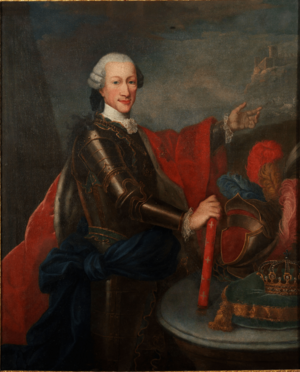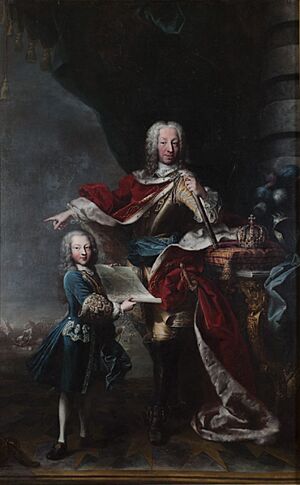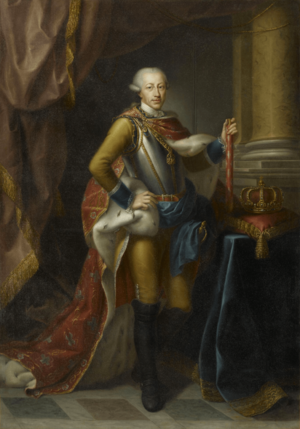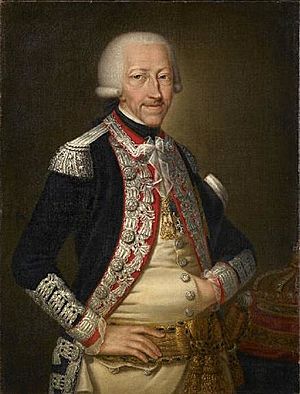Victor Amadeus III of Sardinia facts for kids
Quick facts for kids Victor Amadeus III |
|||||
|---|---|---|---|---|---|

Portrait of Victor Amadeus attributed to Giuseppe Duprà, c. 1775–84
|
|||||
| King of Sardinia and Duke of Savoy | |||||
| Reign | 20 February 1773 – 16 October 1796 | ||||
| Predecessor | Charles Emmanuel III | ||||
| Successor | Charles Emmanuel IV | ||||
| Born | 26 June 1726 Royal Palace, Turin, Savoy |
||||
| Died | 16 October 1796 (aged 70) Castle of Moncalieri, Turin, Savoy |
||||
| Burial | Basilica of Superga, Turin | ||||
| Spouse | |||||
| Issue | Charles Emmanuel IV of Sardinia Princess Marie Joséphine, Countess of Provence Princess Maria Theresa, Countess of Artois Princess Maria Anna, Duchess of Chablais Victor Emmanuel I of Sardinia Prince Maurizio, Duke of Montferrat Maria Carolina, Electoral Princess of Saxony Charles Felix of Sardinia Prince Giuseppe, Count of Asti |
||||
|
|||||
| House | Savoy | ||||
| Father | Charles Emmanuel III of Sardinia | ||||
| Mother | Polyxena of Hesse-Rotenburg | ||||
| Religion | Roman Catholicism | ||||
| Signature |  |
||||
Victor Amadeus III (born Vittorio Amadeo Maria; June 26, 1726 – October 16, 1796) was the King of Sardinia from 1773 until his death. He was a very traditional ruler. However, he made many changes to how the government worked. This was before he went to war with Revolutionary France in 1792. He was the father of the last three kings of Sardinia from his family line.
Contents
Early Life and Royal Training
Victor Amadeus was born at the Royal Palace of Turin. His parents were Charles Emmanuel III of Sardinia and his second wife, Polyxena of Hesse-Rheinfels-Rotenburg. From the moment he was born, he was known as the Duke of Savoy. He held this title until he became king after his father.
He was the oldest son of his parents. Everyone was very happy when he was born because he was the heir apparent, meaning he would inherit the throne. His father had another son, also named Victor Amadeus, who died in 1725.
Victor Amadeus III's education focused a lot on military training. He was taught by Gerdil Giacinto Sigismondo. Throughout his life, he was very interested in the army and spent a lot of time and money on it.
As a young prince, he spent time with smart people and government officials. Many of these people later became important during his rule. He was a private person and very religious. When he was young, he stayed away from public life. His father thought he was not ready to be in charge.
Victor Amadeus was kind-hearted but sometimes a bit naive. His people loved him because he was very generous.
Royal Marriage and Family Life
Victor Amadeus married Infanta Maria Antonia of Spain. She was born in 1729 and died in 1785. Maria Antonia was the youngest daughter of Philip V of Spain and Elisabeth Farnese.
They got married on May 31, 1750, in a place called Oulx. They had twelve children together. Victor Amadeus and Maria Antonia had a loving relationship. She did not try to control her husband's decisions.
This marriage was arranged by Maria Antonia's half-brother, Ferdinand VI of Spain. The Spanish princess had been turned down by Louis, Dauphin of France before. This marriage helped make the relationship between Madrid (Spain) and Turin (Sardinia) stronger. They had fought against each other in the War of the Austrian Succession. The war ended with the Treaty of Aix-la-Chapelle in 1748.
Becoming King of Sardinia
When Victor Amadeus became king in 1773, he focused on improving the government and the military. He was careful about new ideas. However, he did start several public projects. He also paid a lot of attention to how his country was run and to his armed forces.
He approved and created two new important cultural organizations. These were suggested by both the middle class and the rich families. He also began improving the port of Nice. He had dams built in the Arce river and a new road along the coast.
When the French Revolution began, Victor Amadeus III offered protection to his two sons-in-law. He also welcomed the French princesses Marie Adélaïde and Victoire into his kingdom.
After four years of fighting, the French army, led by Bonaparte, defeated the Piedmontese army. This happened in several battles in April 1796. These included the Battle of Montenotte, the Battle of Millesimo, and the Battle of Mondovi.
On April 26, the French declared the Republic of Alba in the areas they had taken over. Two days later, Victor Amadeus got these lands back through an agreement called the Armistice of Cherasco. He was forced to sign the Treaty of Paris on May 15. This meant he had to leave the First Coalition against France.
The treaty made him give up important forts to France. These included Cuneo, Ceva, Alessandria, and Tortona. He also had to let French armies pass freely through his country towards Italy. He was also forced to give up the regions of Nice and Savoy.
Victor Amadeus III died on October 16, 1796, at the Castle of Moncalieri. He had suffered a stroke. He left behind a kingdom that was struggling financially. Two key regions, Savoy and Nice, were damaged by the French revolutionary forces. He was buried at the Basilica of Superga in Turin.
King Victor Amadeus III's Legacy
In 1786, Victor Amadeus III moved the remains of many of his ancestors to the Basilica of Superga. He is also buried there today.
He created the Gold Medal of Military Valor on May 21, 1793. This was a special award for bravery in the military. Like his parents, he made improvements to the Palazzina di caccia of Stupinigi, a hunting lodge near Turin.
Victor Amadeus III also supported the growth of the Orto Botanico dell'Università di Torino, which is a botanical garden. He also started the Società Agraria di Torino in 1785. This group focused on improving farming. His first cousin, the Landgrave of Hesse-Rotenburg, was named after him.
Children of Victor Amadeus III
Victor Amadeus III and Maria Antonia had twelve children. Here are some of them:
- Charles Emmanuel IV of Sardinia (1751 – 1819): He became king after his father. He married Princess Marie Clotilde of France.
- Maria Elisabetta Carlotta of Savoy (1752 – 1755): She died when she was very young.
- Maria Giuseppina of Savoy (1753 – 1810): She married Louis Stanislas, Count of Provence.
- Amadeus Alexander of Savoy (1754 – 1755): He also died as a baby.
- Maria Teresa of Savoy (1756 – 1805): She married Charles, Count of Artois.
- Maria Anna of Savoy (1757 – 1824): She married Prince Benedetto of Savoy.
- Victor Emmanuel I of Sardinia (1759 – 1824): He also became King of Sardinia. He married Archduchess Maria Theresa of Austria-Este.
- Maria Cristina Ferdinanda of Savoy (1760 – 1768): She died when she was a child.
- Maurizio of Savoy (1762 – 1799): He died unmarried from malaria.
- Maria Carolina of Savoy (1764 – 1782): She married Antony, Electoral Prince of Saxony.
- Charles Felix of Sardinia (1765 – 1831): He became King of Sardinia after his brothers. He married Princess Maria Cristina of Naples and Sicily.
- Giuseppe of Savoy (1766 – 1802): He died unmarried from malaria.
See also
 In Spanish: Víctor Amadeo III de Cerdeña para niños
In Spanish: Víctor Amadeo III de Cerdeña para niños







